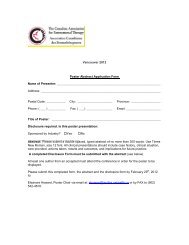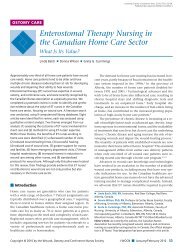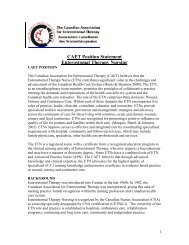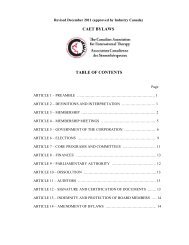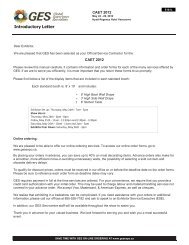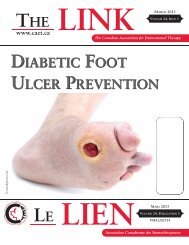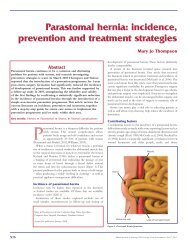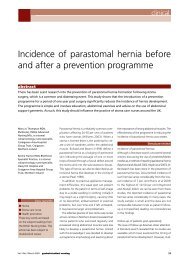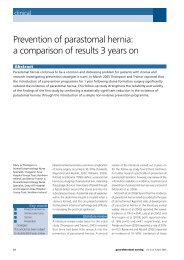March 2008 - CAET - The Canadian Association for Enterostomal ...
March 2008 - CAET - The Canadian Association for Enterostomal ...
March 2008 - CAET - The Canadian Association for Enterostomal ...
Create successful ePaper yourself
Turn your PDF publications into a flip-book with our unique Google optimized e-Paper software.
Featured Article<br />
E.T. Leadership In Pressure Ulcer Prevention<br />
by Nancy Parslow, RNET<br />
Short Biography: I am presently<br />
the Wound Care Specialty Nurse at<br />
Southlake Regional health Centre in<br />
Newmarket. I am also on the RNAO<br />
development panel <strong>for</strong> the new<br />
Ostomy Guideline. In the past I was<br />
on the RNAO development panels<br />
<strong>for</strong> the BPG’s <strong>for</strong> Risk Assessment<br />
and Prevention of Pressure Ulcers,<br />
Assessment and Treatment of Stage<br />
1-4 Pressure Ulcers, Assessment and<br />
Management of Venous leg Ulcers.<br />
I am also involved on the <strong>CAET</strong><br />
certification examination committee<br />
and cirriculum development <strong>for</strong> the<br />
revised educational program.<br />
Pressure ulcer development<br />
increases length of hospital stay,<br />
complexity of care needs, morbidity<br />
and mortality rates, and suffering<br />
from complications associated<br />
with pressure ulcers (Foster, Frisch,<br />
Denis, Forler, and Jago, 1992). <strong>The</strong><br />
use of a program to prevent pressure<br />
ulcers should decrease costs, length<br />
of hospital stay and reduce patient<br />
suffering.<br />
A study conducted across Canada<br />
by Woodbury and Houghton in<br />
2004 identified that the problem<br />
with pressure ulcer development is a<br />
significant occurrence in a variety of<br />
health care settings with an average<br />
prevalence of 26.2 % of patients<br />
having a pressure ulcer.<br />
A review of the evidence presented<br />
in the RNAO Guideline; Risk<br />
Assessment and Prevention of<br />
Pressure Ulcers 2005, estimates<br />
that “10% of patients admitted to<br />
hospital will develop a pressure ulcer,<br />
the elderly are at highest risk with<br />
approximately 70% of all pressure<br />
ulcers occurring in elders. Of those<br />
patients who develop pressure ulcers,<br />
approximately 60% occur in the acute<br />
care setting – usually within the first<br />
two weeks of admission with 15% of<br />
elderly patients estimated to develop<br />
ulcers within one week of admission.<br />
Several studies report mortality rates<br />
32 <strong>The</strong> LINK - <strong>March</strong> <strong>2008</strong><br />
as high as 60% <strong>for</strong> elders with a<br />
pressure ulcer within one year of<br />
discharge from hospital.” (RNAO, pg<br />
20, 2005)<br />
<strong>The</strong> publication of Best Practice<br />
in<strong>for</strong>mation such as that developed by<br />
the <strong>Canadian</strong> <strong>Association</strong> of Wound<br />
Care (CAWC) and Registered Nurses<br />
<strong>Association</strong> of Ontario (RNAO) have<br />
created national awareness of the need<br />
to prevent pressure ulcers and has<br />
established standards of care that can<br />
be used as quality of care indicators.<br />
Programs such as the CAWC Pressure<br />
Ulcer Awareness Program, patient<br />
safety initiatives and accreditation<br />
standards stress the necessity of early<br />
intervention <strong>for</strong> those patients at risk<br />
of developing pressure ulcers (RNAO,<br />
pg. 20- 21 2005). Studies indicate<br />
that the majority of pressure ulcers<br />
are preventable with appropriate<br />
interventions.<br />
<strong>The</strong> development and implementation<br />
of a <strong>for</strong>malized program to prevent<br />
pressure ulcers is often confronted<br />
by many challenges that must be<br />
overcome be<strong>for</strong>e a change in practice<br />
can be effectively incorporated.<br />
Issues related to staff shortages, lack<br />
of available time, lack of leadership<br />
and support <strong>for</strong> the creation of a<br />
program may be common roadblocks<br />
to success. Many clinicians struggle to<br />
obtain the resources and support that is<br />
necessary to implement best practices<br />
<strong>for</strong> pressure ulcer prevention.<br />
I was very <strong>for</strong>tunate to be selected as<br />
a site champion to pilot the CAWC<br />
Pressure Ulcer Awareness Program<br />
(PUAP) <strong>for</strong> my community hospital.<br />
<strong>The</strong> PUAP utilizes a structured team<br />
approach to advocate <strong>for</strong> Pressure<br />
Ulcer (PU) prevention by providing<br />
a supported, organized program<br />
ready <strong>for</strong> implementation by the<br />
site champion. <strong>The</strong> ET nurse who<br />
provides leadership and expertise in<br />
skin and wound management is the<br />
ideal candidate to lead a pressure<br />
ulcer prevention program such<br />
as the PUAP. All site champions<br />
receive mentorship from the<br />
CAWC program leader and other<br />
site champions to support the<br />
development of leadership skills to<br />
overcome challenges and implement<br />
the PUAP program successfully.<br />
This ongoing link to a supportive<br />
network facilitates the development<br />
of creative strategies to manage<br />
adversity and obtain the support<br />
and recognition necessary to<br />
incorporate an interdisciplinary<br />
pressure ulcer prevention program<br />
into everyday practice.<br />
Recognition of the ET nurse as<br />
a leader and expert in pressure<br />
ulcer prevention and management<br />
was enhanced by the role of the<br />
PUAP facilitator. As the various<br />
components of the program were<br />
implemented staff, patients and<br />
families began to identify simple<br />
steps that could be incorporated<br />
into daily routines to maintain<br />
skin integrity without increasing<br />
workload. Colourful posters,<br />
pamphlets, buttons, certificates and<br />
prizes effectively raised awareness<br />
and rein<strong>for</strong>ced goals. Chart audits<br />
and interdisciplinary high risk skin<br />
rounds provided opportunities<br />
<strong>for</strong> education at the bedside<br />
with staff, patients and families<br />
promoting increased knowledge<br />
and skills. Audits also monitored<br />
progress, promoted accountability<br />
and provided progress reports <strong>for</strong><br />
individual units which created<br />
excitement and enthusiasm as each<br />
area strived to improve their patient<br />
outcomes.<br />
Implementation of best practices<br />
promoted a change in patient<br />
outcomes. Re-introduction of the<br />
Braden risk assessment with a<br />
focus on its use as a care planning<br />
tool prompted the development of<br />
individualized plans of care targeted<br />
at interventions to manage the<br />
identified risk factors.<br />
Suite à la page 34/ Continues on page 34.





